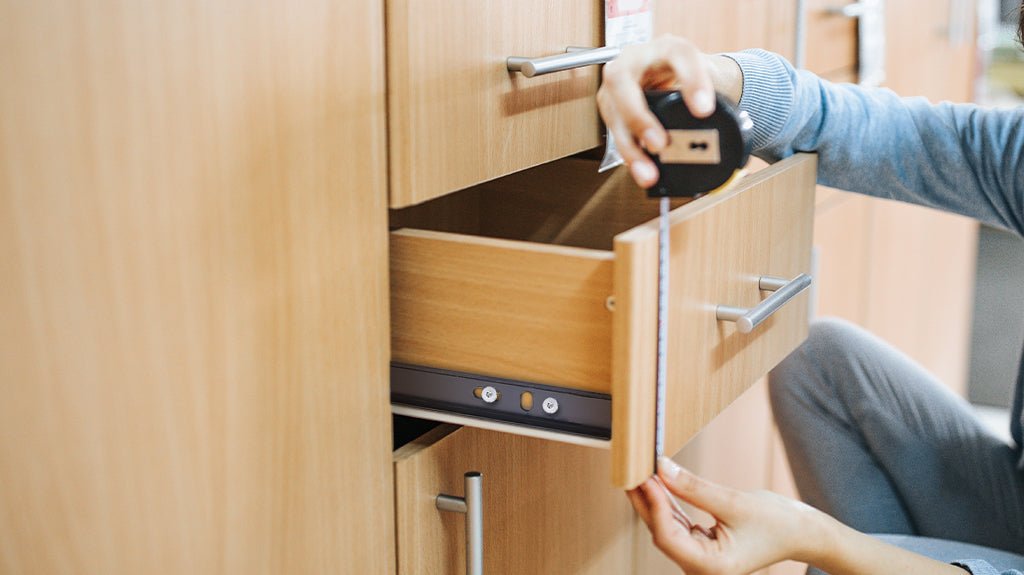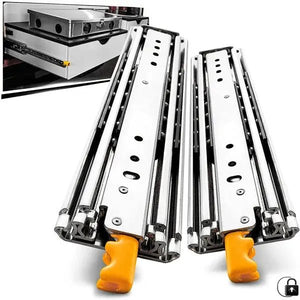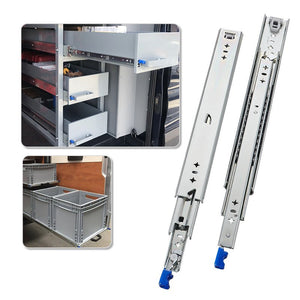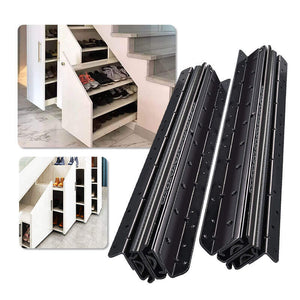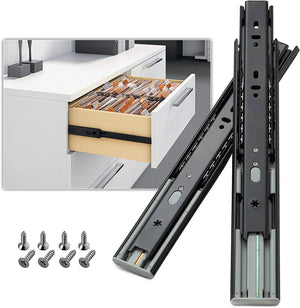Introduction:
Slides, also known as drawer slides or slide rails, are essential components in various applications, providing smooth and controlled movement for drawers, cabinets, machinery, and more. Selecting the right slide for your project is crucial to ensure optimal performance and functionality. In this comprehensive buyer's guide, we will delve into the factors to consider when choosing slides, the different types available, installation tips, and maintenance guidelines to help you make informed decisions and find the perfect slide for your needs.
Basic overview of slide rail structure
Slide rails, also known as drawer slides or drawer glides, are essential components in various applications, providing smooth and controlled movement for drawers, cabinets, machinery, and more. These components consist of several key elements, each contributing to their functionality and performance.
Firstly, let's discuss the materials used in slide rail construction. Slide rails are commonly made from materials such as steel, aluminum, and plastic. Steel is favored for its strength and durability, making it suitable for heavy-duty applications. Aluminum is lightweight and corrosion-resistant, ideal for environments where weight and exposure to moisture are concerns. Plastic slide rails are cost-effective and versatile, often used in lighter-duty applications.
Key components of slide rails include ball bearings and rollers. Ball bearings are small metal spheres that facilitate smooth movement by reducing friction between the sliding components. They are typically housed in races or channels along the length of the slide rails. Rollers, on the other hand, are cylindrical components that roll along the track, providing support and stability to the sliding mechanism.
Common terms used in the industry include "load capacity," referring to the maximum weight the slide rail can support, and "extension type," indicating how far the drawer or component can extend from its closed position. Understanding these terms and components is essential when selecting slide rails for specific applications, ensuring optimal performance and longevity.
Important things to consider when choosing slide rails
Choosing the right slide rail is a critical decision that can significantly impact the functionality and longevity of your project. Several factors must be considered to ensure that you select the most suitable slide rail for your specific application.
Firstly, load capacity is a key consideration when choosing slide rails. The load capacity refers to the maximum weight that the slide rail can support without compromising performance. It is essential to accurately assess the weight of the load that the slide rail will be supporting to avoid overloading and potential failure.
Additionally, the expansion type of the slide rail is another crucial factor to consider. Expansion type refers to how far the slide rail extends from its closed position. Options include full extension, partial extension, and over-travel. The expansion type chosen will depend on the accessibility requirements of your project and the available space constraints.
Finally, the installation method of the slide rail is vital for ensuring proper functionality and stability. Slide rails can be mounted using various methods, including side-mount, under-mount, and center-mount. The installation method chosen should be compatible with the design and structure of your project to ensure a secure and reliable installation.
In conclusion, choosing the right slide rail requires careful consideration of factors such as load capacity, expansion type, and installation method. By thoroughly assessing these factors and selecting slide rails that meet your specific requirements, you can ensure optimal performance and functionality for your project.
Learn about the unique features and benefits of slide rails

Ball Bearing Slide Rails:
Ball bearing slide rails are perhaps the most popular choice for their smooth and quiet operation. These slide rails feature ball bearings that facilitate smooth movement along the track, resulting in effortless opening and closing of drawers or components. They are known for their high load-bearing capacity, making them suitable for heavy-duty applications. Additionally, ball bearing slide rails often have full extension capabilities, providing easy access to the entire drawer or component.
Roller Slide Rails:
Roller slide rails utilize rollers instead of ball bearings to facilitate movement. While they may not offer the same level of smoothness as ball bearing slide rails, they excel in heavy-duty applications where high load-bearing capacity is required. Roller slide rails are commonly used in industrial machinery and equipment where durability and reliability are paramount.
Telescopic Slide Rails:
Telescopic slide rails consist of multiple nested sections that extend and retract, allowing for full access to the drawer or component. These slide rails are ideal for applications where maximum extension and accessibility are required, such as toolboxes, kitchen cabinets, or medical equipment. They offer versatility in design and functionality, allowing for customized solutions to meet specific project requirements.
Soft-Close Slide Rails:
Soft-close slide rails feature a mechanism that slows down the closing action, preventing slamming and ensuring gentle, controlled closure. These slide rails are commonly used in kitchen cabinets, bathroom vanities, and furniture where quiet operation and protection against damage are desired. Soft-close slide rails enhance user experience and contribute to a more comfortable living or working environment.
In conclusion, each slide rail type offers its unique set of characteristics and advantages, catering to different project requirements and preferences. By understanding the specific needs of your project and selecting the appropriate slide rail type, you can ensure smooth operation, durability, and overall satisfaction with the end result. Whether you prioritize smoothness, load capacity, accessibility, or quiet operation, there's a slide rail type that's perfect for your project.
Slide rail installation
Measure Twice, Install Once: Before beginning the installation process, carefully measure the dimensions of the mounting area to ensure that the slide rails fit properly. Accuracy is key to preventing misalignment and ensuring smooth operation.
Choose the Right Mounting Method: Slide rails can be mounted using various methods, including side-mount, under-mount, and center-mount. Select the mounting method that best suits the design and structural requirements of your project.

Follow Manufacturer Instructions: Always refer to the manufacturer's installation instructions for specific guidelines and recommendations. Pay close attention to any special requirements or considerations unique to the slide rail model you are installing.
Ensure Proper Alignment: Proper alignment of the slide rails is crucial for smooth and consistent movement. Use a level or straight edge to ensure that the slide rails are installed parallel to each other and perpendicular to the mounting surface.
Secure Mounting Surface: Ensure that the mounting surface is sturdy and capable of supporting the weight of the slide rails and the load they will bear. Use appropriate fasteners and hardware to securely attach the slide rails to the mounting surface.
Test for Smooth Operation: Once the slide rails are installed, test them to ensure that they operate smoothly and without any binding or sticking. Adjustments may be necessary to fine-tune the alignment and ensure optimal performance.
Consider Safety Precautions: If installing slide rails in a commercial or industrial setting, be mindful of safety precautions such as weight capacity limits and proper anchoring to prevent accidents or injuries.
Maintaining slide rails is essential to ensure smooth and reliable operation over time. Here are some quick tips to keep your slide rails in top condition:
1. Regular Cleaning: Remove dirt, dust, and debris from the slide rails using a soft brush or cloth.
2. Lubrication: Apply a silicone-based lubricant to the moving parts of the slide rails to reduce friction and ensure smooth operation.
3. Check for Wear: Inspect the slide rails periodically for signs of wear or damage, such as bent or broken components.
4. Tighten Fasteners: Ensure that all screws and fasteners are tightened securely to prevent loosening over time.
With these simple maintenance practices, you can prolong the lifespan and performance of your slide rails, keeping them operating smoothly for years to come.
By following these slide rail installation tips, you can ensure that your project is completed with precision, reliability, and safety in mind. Proper installation not only enhances functionality but also contributes to the longevity and performance of the slide rails, ensuring years of trouble-free operation.
Conclusion:
Choosing the right slide for your project is crucial to ensure optimal performance and functionality. By considering factors such as load capacity, extension type, and mounting method, exploring different slide types, and following installation and maintenance guidelines, you can find the perfect slide to meet your needs and bring your project to life.

